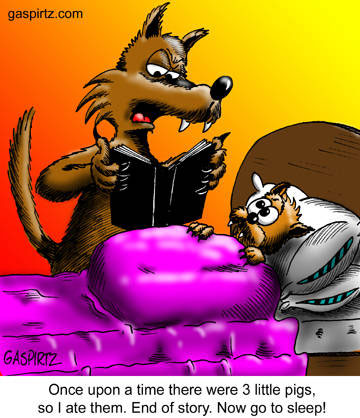First-person stories are told from the point of view of the narrator. The reader experiences the story through the eyes, ears, thoughts, and feelings of the narrator. The narrator uses phrases like I saw, I feel, I heard, and so on. While first-person point of view is easy to recognize, it’s important to remember that just like the scenario from the introduction to this lesson, the narrator is only including details that he or she experienced firsthand. As the reader, you need to determine whether you are getting the whole story and what might be missing from the narrator’s account.
Let’s use a familiar story to help you think about the importance of understanding point of view.

You are probably familiar with the story The Three Little Pigs. Three pigs go into the world to seek their fortunes, and they encounter the Big Bad Wolf, who would love nothing more than to eat the little pigs. Each pig builds a house: one of straw, one of sticks, and one of bricks. The wolf huffs and puffs and destroys the first two houses and eats the pigs. When he gets to the brick house, the wolf can’t blow it down, so he slips down the chimney and ends up in a vat of boiling water. This fairy tale isn’t usually told from the wolf’s point of view. There is somebody else telling the story about the wolf and the pigs, but let’s try reading the story as if it were told from the wolf’s point of view. Your job is to take what you already know about the story, listen to what the wolf is saying, and decide if he’s telling the truth.
Read the excerpt below from The True Story of the Three Little Pigs by A. Wolf by Jon Scieszka and Lane Smith (1989) for a first-person account of the story of the three little pigs.
Everybody knows the story of the Three Little Pigs. Or at least they think they do. But I'll let you in on a little secret. Nobody knows the real story because nobody has ever heard my side of the story. I'm the wolf. Alexander T. Wolf. You can call me Al. I don't know how this whole Big Bad Wolf thing got started, but it's all wrong. Maybe it's because of our diet. Hey, it's not my fault wolves eat cute little animals like bunnies and sheep and pigs. That's just the way we are. If cheeseburgers were cute, folks would probably think you were Big and Bad, too. But like I was saying, the whole Big Bad Wolf thing is all wrong. The real story is about a sneeze and a cup of sugar.
THIS IS THE REAL STORY.
Way back in Once Upon a Time, I was making a birthday cake for my dear old granny. I had a terrible sneezing cold. I ran out of sugar. So I walked down the street to ask my neighbor for a cup of sugar. Now this neighbor was a pig. And he wasn't too bright either. He had built his whole house out of straw. Can you believe it? I mean who in his right mind would build a house of straw? So of course the minute I knocked on the door, it fell right in. I didn't want to just walk into someone else's house. So I called, "Little Pig, Little Pig, are you in?" No answer. I was just about to go home without the cup of sugar for my dear old granny's birthday cake.
That's when my nose started to itch. I felt a sneeze coming on. Well I huffed. And I snuffed. And I sneezed a great sneeze.
And you know what? The whole darn straw house fell down. And right in the middle of the pile of straw was the First Little Pig—dead as a doornail. He had been home the whole time. It seemed like a shame to leave a perfectly good ham dinner lying there in the straw. So I ate it up. Think of it as a cheeseburger just lying there. I was feeling a little better. But I still didn't have my cup of sugar.
This excerpt is a great example of the power and challenges of reading in the first-person point of view. Because we are familiar with the story of the three little pigs, we can evaluate the wolf’s statements and decide whether we think the wolf is telling the “true” story (as he claims). However, you probably won’t know the back story to much of what you read, so it is important to read first-person narration very closely for clues that might help you determine whether the narrator is telling you the truth or his or her version of the truth.